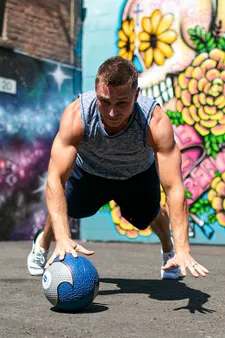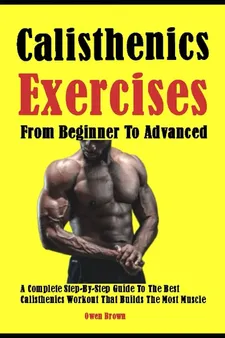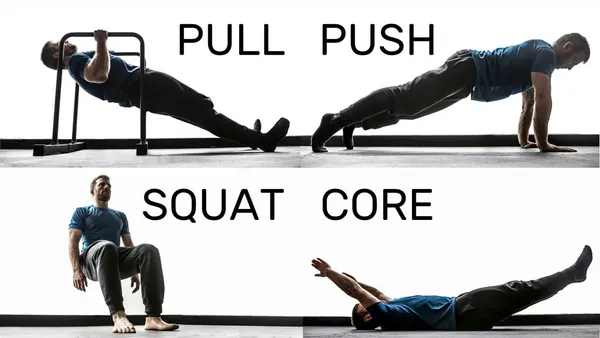Table of Contents
Are you ready to take your fitness to the next level with the best calisthenics workout? Calisthenics is a form of bodyweight training exercises that can help you build strength, muscle, and flexibility. It's a great way to get in shape without having to go to the gym or buy expensive equipment. This article will guide you through the best calisthenics workout routine for beginners. Whether you're new to calisthenics or looking to up your game, Kizworld has everything you need to get started.
The Ultimate Guide to the Best Calisthenics Workout for Beginners
| Workout Level | Exercises | Reps | Sets | Rest | |---|---|---|---|---|---| | Beginner | Push-ups, Squats, Crunches | 10-15 | 2-3 | 60 seconds | | Intermediate | Pull-ups, Dips, Burpees | 8-12 | 3-4 | 90 seconds | | Advanced | Planche, Handstand Push-ups, Muscle-ups | 5-8 | 4-5 | 120 seconds |
I. Best Calisthenics Workout: A Comprehensive Guide to Bodyweight Training
What is Calisthenics?
Calisthenics is a form of bodyweight training that uses your own body weight as resistance. It is a great way to build strength, muscle, and endurance, and it can be done anywhere, anytime. Calisthenics exercises are often used in military training, gymnastics, and parkour.
Benefits of Calisthenics
There are many benefits to calisthenics, including:
- Increased strength and muscle mass
- Improved endurance
- Enhanced flexibility and mobility
- Reduced risk of injury
- Improved balance and coordination
- Increased self-confidence
Getting Started with Calisthenics
If you are new to calisthenics, it is important to start slowly and gradually increase the intensity of your workouts over time. Begin with basic exercises such as push-ups, squats, and crunches. As you get stronger, you can add more challenging exercises such as pull-ups, dips, and muscle-ups.It is also important to listen to your body and rest when you need to. Do not push yourself too hard, especially when you are first starting out. If you experience any pain, stop exercising and consult with a doctor.
Calisthenics Workouts
There are many different calisthenics workouts that you can do. The best workout for you will depend on your fitness level and goals. If you are new to calisthenics, start with a beginner workout and gradually increase the intensity as you get stronger.Here is a sample calisthenics workout for beginners:
- Warm-up: 5 minutes of light cardio, such as jogging or jumping jacks
- Exercises:
- Push-ups: 10-15 repetitions
- Squats: 10-15 repetitions
- Crunches: 10-15 repetitions
- Rest: 60 seconds
- Repeat for 2-3 sets
- Cool-down: 5 minutes of stretching
As you get stronger, you can add more challenging exercises to your workout, such as pull-ups, dips, and muscle-ups. You can also increase the number of sets and repetitions.
Tips for Calisthenics
Here are a few tips for getting the most out of your calisthenics workouts:
- Use proper form. This will help you to avoid injury and get the most out of your exercises.
- Be consistent. The more you practice, the stronger you will become.
- Challenge yourself. As you get stronger, add more challenging exercises to your workout.
- Listen to your body. Rest when you need to and do not push yourself too hard.
- Have fun! Calisthenics is a great way to get fit and have fun at the same time.
Related Posts
- How to Do a Muscle-Up
- The Best Calisthenics Gifts and Accessories
- The Best Calisthenics Quotes and Motivation
Workout Level | Exercises | Reps | Sets | Rest |
|---|---|---|---|---|
Beginner | Push-ups, Squats, Crunches | 10-15 | 2-3 | 60 seconds |
Intermediate | Pull-ups, Dips, Burpees | 8-12 | 3-4 | 90 seconds |
Advanced | Planche, Handstand Push-ups, Muscle-ups | 5-8 | 4-5 | 120 seconds |
Best Calisthenics Workout: A Comprehensive Guide to Bodyweight Training
II. Calisthenics Exercises for Beginners: A Step-by-Step Guide to Getting Started
Get the Basics Right
Before you start any calisthenics workout, it's important to learn the basics. This includes proper form and technique, as well as how to warm up and cool down. Once you have a solid foundation, you can start adding more challenging exercises to your routine.
Here's a few tips to dedicate to be a solid foundation for your training: How to Get Started with Calisthenics as a Beginner.
Some basic calisthenics exercises for beginners include:
- Push-ups
- Squats
- Crunches
Start Slowly
When you're first starting out, it's important to start slowly and gradually increase the intensity of your workouts over time. This will help to prevent injuries and allow your body to adapt to the new demands of calisthenics.
Try the first table as your first month training plan: How to Design Your Own Calisthenics Routine and Program.
| Workout Level | Exercises | Reps | Sets | Rest ||---|---|---|---|---|---|| Beginner | Push-ups, Squats, Crunches | 10-15 | 2-3 | 60 seconds |
Listen to Your Body
It's important to listen to your body and take breaks when you need them. Don't push yourself too hard, especially when you're first starting out. If you're experiencing any pain, stop exercising and consult with a doctor or physical therapist.
Be Consistent
The key to success with calisthenics is to be consistent with your workouts. Aim to workout at least 3 times per week, and gradually increase the frequency and intensity of your workouts over time.
Have Fun!
Calisthenics is a great way to get fit and have fun at the same time. So enjoy the process and don't be afraid to experiment with different exercises and routines.
III. Advanced Calisthenics Workout: Pushing the Limits of Bodyweight Training
Mastering Advanced Calisthenics Skills
Advanced calisthenics workouts are designed to push the limits of your bodyweight training. They incorporate challenging exercises that require strength, power, and flexibility. Mastering these skills can take years of practice, but the results are well worth the effort.Some of the most popular advanced calisthenics skills include:
- The planche: A hold where you support your body on your hands, with your body parallel to the ground.
- The handstand push-up: A push-up performed while in a handstand.
- The muscle-up: A pull-up followed by a dip.
These exercises are not for the faint of heart, but they can be incredibly rewarding to master. If you're looking to take your calisthenics training to the next level, start by working on these advanced skills.
Benefits of Advanced Calisthenics Workouts
There are many benefits to performing advanced calisthenics workouts. These workouts can help you:
- Increase your strength and power.
- Improve your flexibility and range of motion.
- Build muscle and lean body mass.
- Reduce your risk of injury.
- Improve your overall fitness level.
If you're looking for a challenging and rewarding workout, advanced calisthenics is a great option.
How to Get Started with Advanced Calisthenics
If you're new to advanced calisthenics, it's important to start slowly and gradually increase the difficulty of your workouts. Start by mastering the basic calisthenics exercises, such as push-ups, pull-ups, and squats. Once you have a solid foundation, you can start to add more challenging exercises to your routine.It's also important to listen to your body and rest when you need to. Don't try to do too much too soon, or you'll risk injury. With patience and perseverance, you'll be able to master advanced calisthenics skills.
Exercise | Difficulty | Benefits |
|---|---|---|
Planche | Advanced | Strength, power, flexibility |
Handstand push-up | Advanced | Strength, power, flexibility |
Muscle-up | Advanced | Strength, power, flexibility |
Advanced Calisthenics Workout: Pushing the Limits of Bodyweight Training
IV. Calisthenics Workout Plan: A Personalized Approach to Fitness
Crafting a personalized calisthenics workout plan requires careful consideration of your individual goals, fitness level, and lifestyle. Whether you're a seasoned athlete or just starting your fitness journey, tailoring your workout to your specific needs is key to maximizing results. Here's a step-by-step guide to designing a calisthenics plan that fits like a glove:
Assess Your Goals and Fitness Level
Start by identifying your fitness goals. Are you aiming to build muscle, lose weight, or improve overall strength and mobility? Determine your current fitness level by assessing your strength, endurance, and flexibility. This will help you set realistic goals and choose exercises that are appropriate for your abilities.
Related: How to Design Your Own Calisthenics Routine and Program
Choose the Right Exercises
The vast world of calisthenics offers a multitude of exercises to choose from. Select exercises that target the muscle groups you want to work and match your fitness level. For beginners, start with fundamental movements like push-ups, squats, and lunges. As you progress, incorporate more advanced exercises such as handstands, muscle-ups, and planche.
Beginner Exercises | Intermediate Exercises | Advanced Exercises |
|---|---|---|
Push-ups | Pull-ups | Planche |
Squats | Dips | Handstand Push-ups |
Lunges | Burpees | Muscle-ups |
Plan Your Workout Schedule
The frequency and duration of your workouts will depend on your fitness level and goals. Beginners may start with 2-3 workouts per week, gradually increasing the frequency as they progress. Each workout should last around 30-45 minutes, including warm-up and cool-down. As you get stronger, incorporate supersets, drop sets, and other intensity-boosting techniques to challenge your muscles.
Related: How to Train Like a Calisthenics Pro
Progressive Overload
To continuously improve, you need to challenge your muscles with progressive overload. Gradually increase the difficulty of your workouts by adding weight, repetitions, sets, or exercise variations. This forces your body to adapt and grow stronger. However, remember to listen to your body and rest when needed to avoid injury.
- Add weight: Use a weighted vest or resistance bands to increase the intensity of exercises.
- Increase repetitions or sets: Gradually add more reps or sets to your exercises as you get stronger.
- Try exercise variations: Explore different variations of exercises to target different muscle groups or increase the challenge.
Calisthenics Workout Plan: A Personalized Approach to Fitness
V. Conclusion
Calisthenics is a great way to get in shape and improve your overall health. It is a versatile form of exercise that can be done anywhere, anytime. With a little creativity, you can create a calisthenics workout that is challenging and effective. So what are you waiting for? Get started today and see the amazing benefits that calisthenics has to offer!